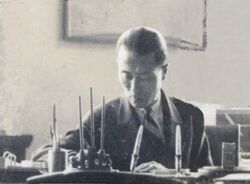Biography:Wong Tsu
Wong Tsu | |
|---|---|
 Wong Tsu in his office at CAMCO, Hangzhou | |
| Born | August 10, 1893 Beijing, Qing China |
| Died | March 4, 1965 (aged 71) Tainan, Taiwan, Republic of China |
| Nationality | Republic of China |
| Education | Massachusetts Institute of Technology |
| Engineering career | |
| Employer(s) | Boeing |
| Awards | Acknowledged as first Boeing engineer at the Museum of Flight |
Wong Tsu (1893–1965; Chinese: 王助) was a Chinese aeronautical engineer. He has been recognized as the first engineer at Boeing.
Life and education
Tsu was born in Beijing, China . At the age of 12, he was selected as a naval cadet, and at 16 he was sent to England to study naval engineering, then to the U.S. to study aeronautical engineering at the Massachusetts Institute of Technology (MIT).
In the U.S. his name is sometimes inverted to Tsu Wong, to put the family name last, as is the western custom.
Work
Wong Tsu graduated in 1916 from MIT. He then learned to fly at the Curtiss Flying Boat School in Buffalo, New York. In May 1916 the fledgling Boeing Aircraft Company hired him,[1] and he helped design its first successful product, the Boeing Model C,[2][3] more than 50 of which the U.S. Navy purchased.[2] He also brought considerable expertise in wind tunnel testing to Boeing, and advised on the design of the Boeing Aerodynamical Chamber at the University of Washington. In 1917, after around a year at Boeing, he returned to China where he became chief secretary of the airline China National Aviation Corporation. in 1934 -1937 he served as the chief engineer of he Central Aircraft Manufacturing Company, (CAMCO) a joint venture between China and Curtiss-Wright Corporation, Douglas Aviation and Intercontinent Aviation.[4]
When the Kuomintang government was defeated in the Chinese civil war, Wong went to Taiwan where he became professor of aviation at National Cheng Kung University. He died on March 4, 1965 in Tainan at the age of 71.
During his lifetime, Wong is believed to have had a hand in designing 30 aircraft.[which?] In 2004, at a time when Boeing was hoping to increase its ties to the Chinese aviation industry, Boeing unveiled a plaque and exhibit at its Museum of Flight in Seattle, Washington, honoring his work as its first engineer.[5]
References
- ↑ Areddy, James (24 September 2015). "The Chinese Birdman Who Got U.S. Aircraft Giant Boeing Flying". https://blogs.wsj.com/chinarealtime/2015/09/24/the-chinese-birdman-who-got-u-s-aircraft-giant-boeing-flying/.
- ↑ 2.0 2.1 Bauer, Eugene (2000). Boeing: the first century. TABA Publishing. pp. 18. ISBN 1879242095.
- ↑ Fallows, James (2013). China Airborne: The Test of China's Future. Knopf Doubleday. pp. 50. ISBN 9781400031276.
- ↑ Arnold, Doris ("Missy") (2008). Missy's China, Letters from Hangchow 1934 -1937. Hong Kong: Old China Hand Press,. pp. passim. OCLC 488467698.
- ↑ Vu, Carol. "An aviation pioneer, no longer forgotten" (in en-US). http://www.nwasianweekly.com/2005/11/an-aviation-pioneer-no-longer-forgotten/.
External links
- Eve Dumovich, "The 1st and the Best"

